Hello there, fellow plant lover! Are you ready to embark on a journey of nurturing and caring for one of the most captivating indoor plants? Let me introduce you to the Maranta Fascinator, also known as the Prayer Plant. This stunning beauty, belonging to the Calathea family, brings a touch of tropical splendor into our homes.
As a plant enthusiast myself, I understand the joy and sense of fulfillment that comes from cultivating and tending to indoor plants. The Maranta Fascinator, with its vibrant foliage and intricate leaf patterns, has won the hearts of many UK plant lovers. Its graceful leaves, reminiscent of praying hands, move throughout the day, adding a mesmerizing touch to any space.
Join me as I guide you through the essential care tips for your Maranta Fascinator. Together, we’ll explore everything from the plant’s light requirements and watering needs to propagation techniques and common problems. By the end, you’ll be equipped with the knowledge and confidence to ensure the health and vitality of your beloved Maranta Fascinator.
Appearance of Maranta Fascinator (Prayer Plant)
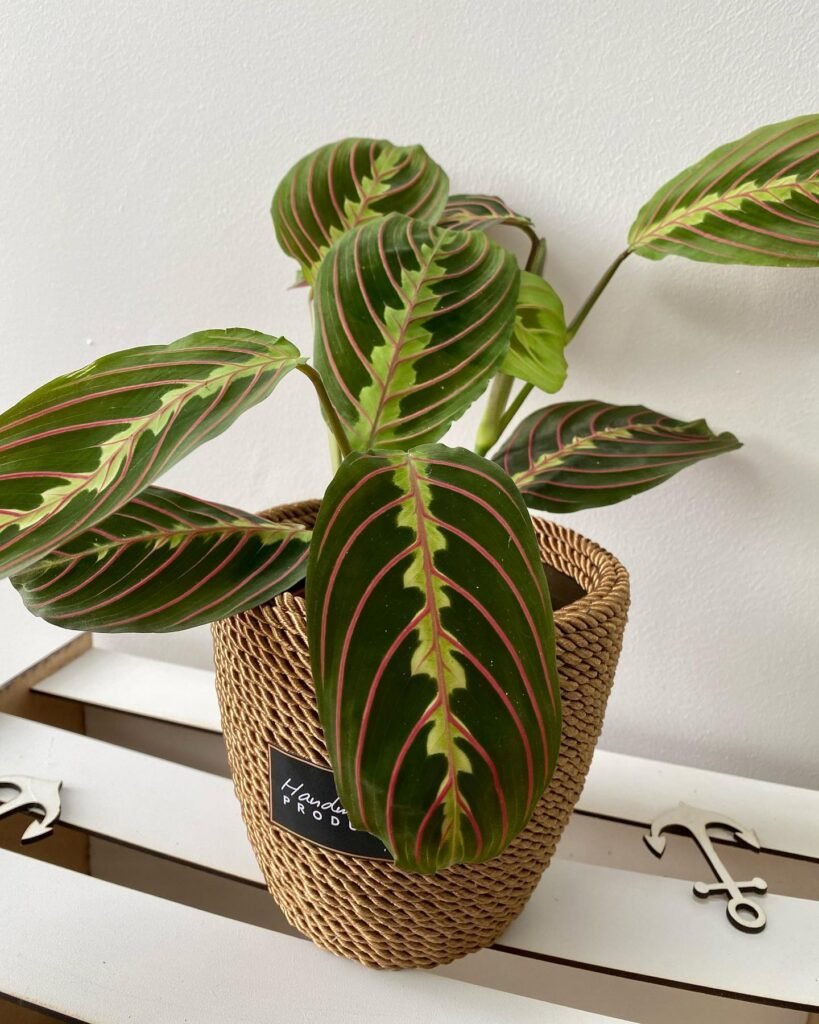

The Maranta Fascinator, also known as the Prayer Plant, is a clumping perennial plant that adds a touch of beauty and elegance to any indoor space. With its vibrant foliage and unique leaf patterns, it is truly a sight to behold. The plant typically reaches a height of up to 12 inches and can spread up to 24 inches wide, creating a lush and full appearance.
One of the most striking features of the Maranta Fascinator is its large, oval leaves. These leaves display a variety of patterns that can vary depending on the specific variety grown. From vibrant greens to deep reds, the leaf colors are a visual delight. Moreover, the undersides of the leaves often exhibit different shades, adding an extra dimension to the plant’s overall appearance.
There are several popular varieties of Maranta Fascinator, each with its own unique characteristics. The Tricolor variety showcases stunning leaves with a mix of green, red, and cream-colored patterns. The Kerchoveana variety boasts rich green leaves with striking white veins. If you prefer a splash of yellow in your indoor garden, the Lemon-Lime variety features vibrant yellow-green leaves. Additionally, the Massangeana and Silver Band varieties offer their own beautiful foliage patterns.
While the Maranta Fascinator occasionally produces tiny white blooms, it is primarily cultivated for its stunning foliage. The combination of its unique leaf patterns, vibrant colors, and lush growth make it a standout addition to any plant collection.
 Did you know the Maranta Fascinator has a unique ability to react to its surroundings? This plant can adjust its leaf orientation in response to the light throughout the day to maximize photosynthesis. This fascinating process, known as photonasty, showcases the plant’s adaptive behaviour, making it not just a visual delight but a remarkable example of nature’s intelligence.
Did you know the Maranta Fascinator has a unique ability to react to its surroundings? This plant can adjust its leaf orientation in response to the light throughout the day to maximize photosynthesis. This fascinating process, known as photonasty, showcases the plant’s adaptive behaviour, making it not just a visual delight but a remarkable example of nature’s intelligence.
Light Requirements for Maranta Fascinator


The Maranta Fascinator, known as the Prayer Plant, is a tropical beauty that thrives in bright, indirect light. To ensure optimal growth and vibrant foliage, it’s crucial to provide your Maranta Fascinator with the right amount of light. Here are some essential tips on light requirements for this stunning houseplant:
1. Bright, Indirect Light
Your Maranta Fascinator loves bright, indirect light. Place it near a window where it can receive several hours of gentle morning or afternoon sun. The filtered light through a sheer curtain is ideal. Avoid exposing the plant to direct sunlight as it can scorch the delicate leaves.
2. Finding the Right Balance
It’s important to find the perfect balance of light for your Maranta Fascinator. If you notice that the plant’s leaves are fading or losing their vibrant color, it may be an indication that it needs more light. On the other hand, if the leaves are turning brown or developing burned patches, it may be receiving too much direct sunlight. Adjust the placement of your plant accordingly to achieve the best light conditions.
3. Low Light Tolerance
The Maranta Fascinator also has a moderate tolerance for low light conditions. It can adapt to lower light levels, but its growth may slow down, and the foliage may lose some of its vibrancy. If you must place it in a low light area, consider supplementing with artificial grow lights to provide the necessary light intensity.
The Maranta Fascinator thrives in bright, indirect light. Place it near a window where it can receive several hours of gentle morning or afternoon sun.

Watering Tips for Maranta Fascinator (Prayer Plant)

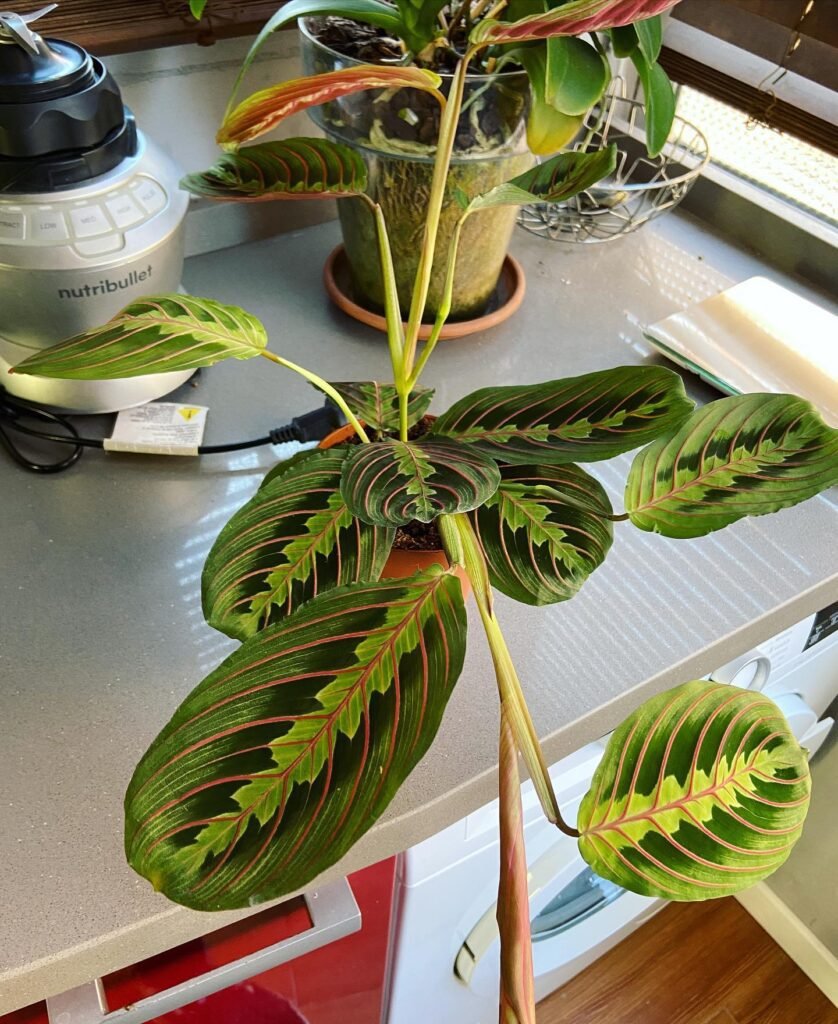
Proper watering is crucial for the health of your Maranta Fascinator. It is important to keep the soil consistently moist but not waterlogged.
Water your plant thoroughly, allowing the top inch of soil to dry out before watering again. This will prevent overwatering, which can lead to root rot.
Using room temperature or filtered water is recommended to avoid chlorine or mineral buildup that can harm the plant.
Regularly check the moisture level of the soil by sticking your finger into the soil up to the first knuckle. If the soil feels dry at this depth, it’s time to water your Maranta Fascinator. Adjust your watering frequency accordingly, taking into account the season and environmental conditions. Keep in mind that the plant may require more frequent watering during warmer months and less frequent watering during cooler months.
Remember that the Maranta Fascinator is native to tropical regions, so it prefers a slightly higher humidity level. To increase humidity around the plant, you can place a tray of water near it or use a humidifier. Mist the leaves occasionally to provide additional moisture and help prevent them from drying out.
If you notice the leaves of your Maranta Fascinator wilting or curling, it may be a sign of underwatering. In this case, water the plant immediately and observe its response. Over time, you’ll become more familiar with your plant’s individual watering needs.

Fertilizing and Soil for Prayer Plant
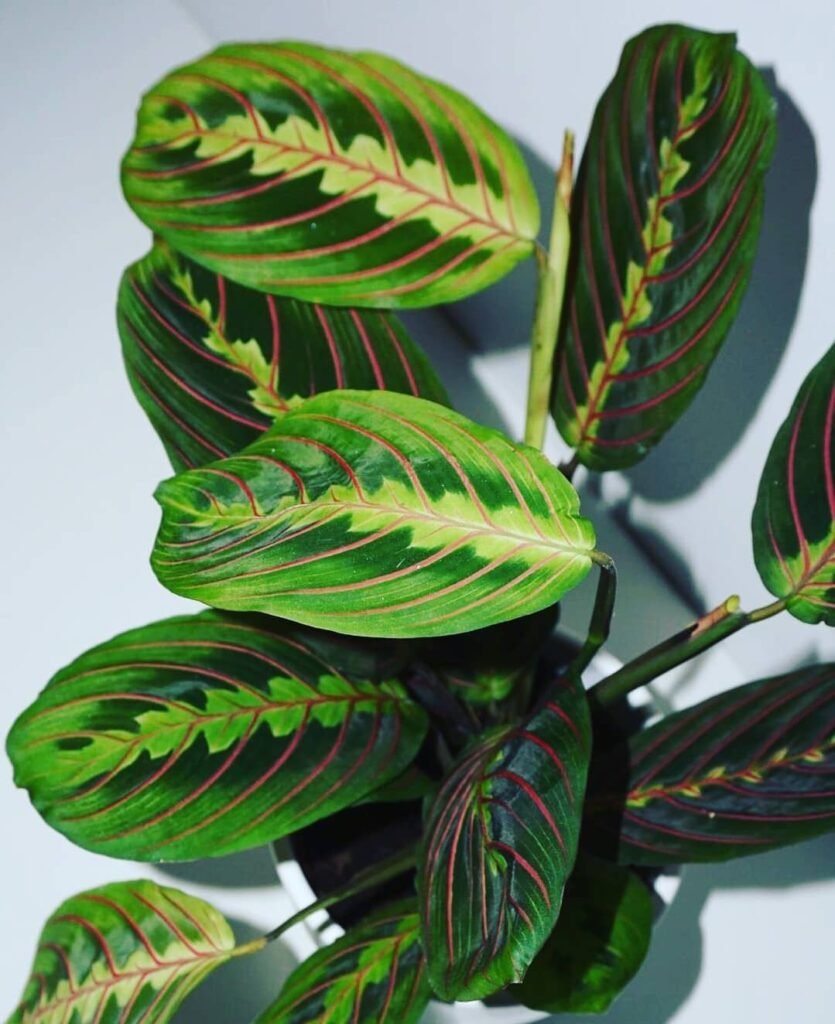

Fertilizing your Maranta Fascinator is essential to provide it with the necessary nutrients for healthy growth. I recommend using a balanced, water-soluble fertilizer diluted to half the recommended strength. Apply the fertilizer monthly during the growing season, which typically occurs in spring and summer. It is advisable to avoid fertilizing during the dormant period in winter.
The Maranta Fascinator thrives in well-draining soil with good moisture retention. To create the ideal soil mix, use a high-quality potting mix that contains peat moss, perlite, and a small amount of sand. This combination provides the necessary drainage while maintaining sufficient moisture levels for the plant’s roots.
When choosing a container for your Maranta Fascinator, opt for one with drainage holes to ensure proper drainage and prevent water from pooling at the bottom. Proper drainage is crucial to prevent waterlogged soil, which can lead to root rot and other issues.

Pruning and Maintenance for Maranta Fascinator

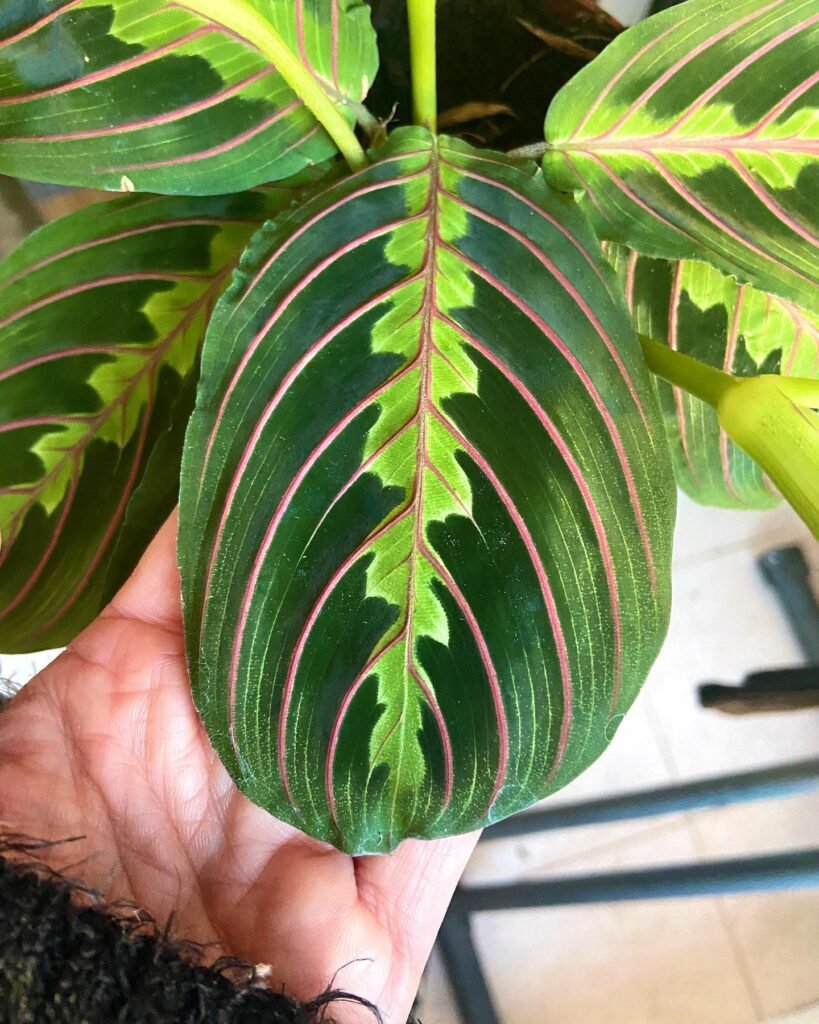
Regular pruning is essential for maintaining the shape and appearance of your Maranta Fascinator. To keep your plant looking its best, follow these pruning tips:
- Remove yellow or brown leaves: Trim any discolored leaves to promote healthier growth and maintain the plant’s aesthetic.
- Trim leggy stems: To encourage bushier growth and fuller foliage, trim back long, leggy stems. This will help keep the plant compact and prevent it from becoming too sprawling.
When pruning your Maranta Fascinator, it is important to use clean and sharp scissors or garden shears. This will minimize the risk of damaging the plant and ensure clean cuts for optimal healing.
Tip: Prune your Maranta Fascinator in spring or summer, when the plant is actively growing and has the best chance of recovering quickly from any pruning.
In addition to pruning, regular maintenance tasks are vital for the overall health and vitality of your Maranta Fascinator. Here’s what you should do:
- Dust the leaves: Gently wipe the leaves with a soft, damp cloth to remove dust accumulation. This will help the plant breathe and maintain its natural shine.
- Inspect for pests or diseases: Regularly check your Maranta Fascinator for signs of pests, such as spider mites or mealybugs. Also, keep an eye out for any signs of diseases, like leaf spots or wilting. If detected, take appropriate action to treat the issue promptly.

Propagating Maranta Fascinator (Prayer Plant)
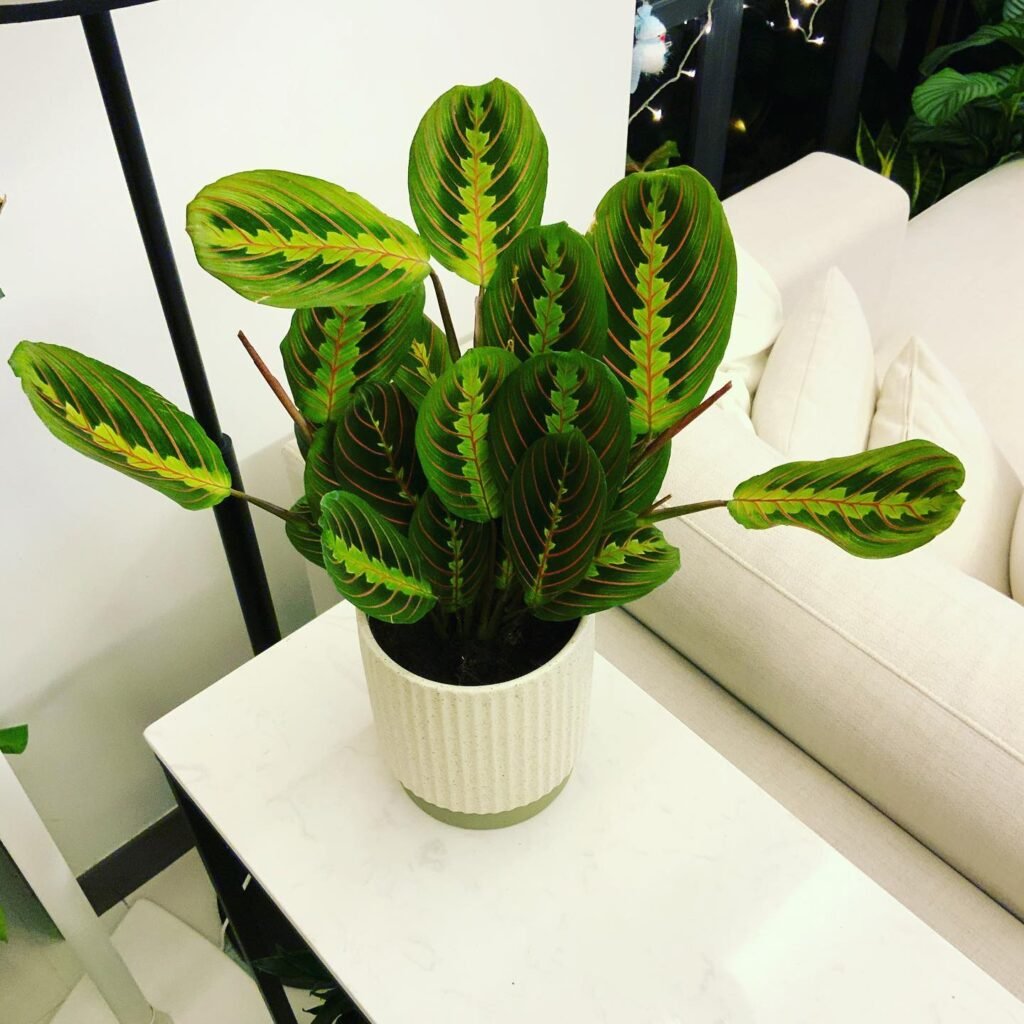

Propagating your Maranta Fascinator is a rewarding way to expand your plant collection or share it with others. One common method of propagation is through stem cuttings. Select a healthy stem with at least one node (bump) and make a clean cut just below the node. Place the cutting in a container filled with a well-draining potting mix and keep it in a warm and humid environment. Mist the cutting regularly to maintain adequate moisture levels. Roots should develop within a few weeks, indicating successful propagation. Another method is by division, where you carefully separate the new growth from the mother plant and repot them individually.

Repotting Tips for Maranta Fascinator
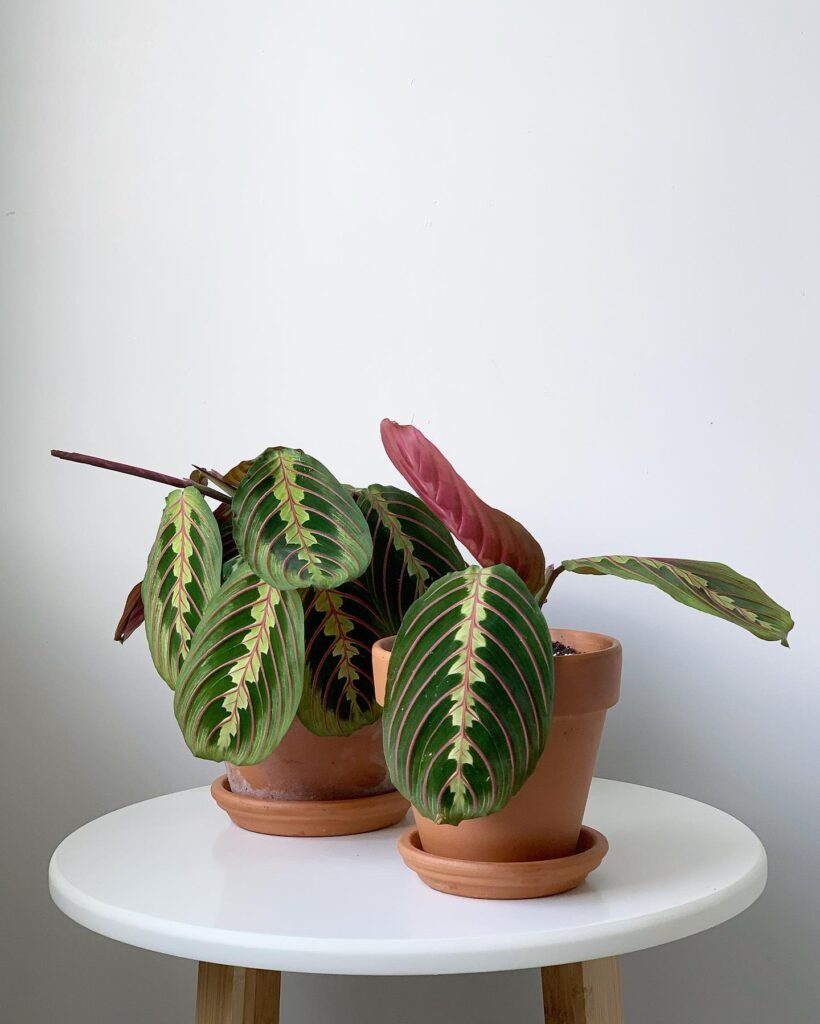

Repotting your Maranta Fascinator is essential for its healthy growth and development. Whether your plant has outgrown its current container or the soil has become compacted, repotting will provide it with the space and nutrients it needs to thrive. Here are some useful tips to guide you through the repotting process:
- Choose the right pot: Select a slightly larger pot with drainage holes to accommodate the growing root system of your Maranta Fascinator. This will prevent the plant from becoming root-bound and allow for proper water drainage.
- Handle with care: When repotting your Maranta Fascinator, be gentle to avoid damaging its delicate roots. Carefully loosen the roots from the old pot and gently place the plant in its new container.
- Use well-draining soil: Ensure that you use a high-quality potting mix that provides good drainage. A mixture of peat moss, perlite, and a small amount of sand is ideal for promoting healthy root growth.
- Position the plant correctly: Place your Maranta Fascinator at the same depth as it was in its previous pot. Avoid burying the stem too deep, as this can lead to rotting. The crown of the plant should be just above the soil surface.
- Water thoroughly: After repotting, give your Maranta Fascinator a thorough watering to help settle the soil and eliminate any air pockets. Ensure that water drains freely from the bottom of the pot.
- Care for the newly repotted plant: After repotting, provide your Maranta Fascinator with the appropriate care, including suitable light conditions, proper watering, and regular fertilization. This will support healthy root development and overall plant growth.
Common Problems and Solutions
While the Maranta Fascinator is generally a resilient plant, it can encounter some common problems. Here are a few issues you may come across with your Prayer Plant:
- Yellow leaves: Yellowing leaves in your Maranta Fascinator may indicate overwatering or improper light conditions. Ensure you are not overwatering the plant and adjust the light levels accordingly.
- Brown tips: Brown tips on the leaves can be caused by low humidity or excessively dry soil. Increase the humidity around the plant by misting its leaves or using a humidifier, and ensure the soil is consistently moist.
- Drooping leaves: Drooping leaves may indicate underwatering or root issues. Check the moisture level of the soil and water the plant thoroughly when needed. If the problem persists, inspect the roots for any signs of damage or rot.
- Pests: Spider mites or mealybugs may occasionally affect your Maranta Fascinator. Regularly inspect the plant for signs of pests, such as visible webbing or small white bugs. If you notice any infestation, use an appropriate insecticidal soap or horticultural oil following the product instructions to control the pests.
Remember to regularly inspect your Maranta Fascinator for signs of pests or diseases, and take appropriate action promptly. Providing the correct care, including proper watering, lighting, and humidity levels, can help prevent and address these issues, ensuring your Prayer Plant remains healthy and thriving.
 The Maranta Fascinator, or Prayer Plant, mimics praying hands with its night-time leaf movements. It’s a natural spectacle with vibrant leaves and air-cleaning perks, adding both beauty and wellness to homes.
The Maranta Fascinator, or Prayer Plant, mimics praying hands with its night-time leaf movements. It’s a natural spectacle with vibrant leaves and air-cleaning perks, adding both beauty and wellness to homes.
Benefits of Maranta Fascinator (Prayer Plant)
The Maranta Fascinator, known as the Prayer Plant, offers a plethora of benefits that make it a perfect choice for indoor plant enthusiasts in the UK. With its vibrant foliage and unique leaf patterns, this plant adds a touch of beauty and elegance to any indoor space.
The prayer-like leaf movements of the Maranta Fascinator further enhance its visual appeal, captivating the attention of all who behold it.
What sets the Maranta Fascinator apart from other indoor plants is its exceptional air-purifying properties. This remarkable plant actively works to improve the air quality in your home by removing pollutants and releasing oxygen. As a result, it contributes to a healthier and more comfortable indoor environment, benefiting both you and your loved ones.
In addition to its aesthetic and air-purifying advantages, having a Maranta Fascinator in your living space holds the potential to provide you with numerous health benefits. Breathing cleaner, fresher air can help reduce allergy symptoms, respiratory issues, and even boost your overall well-being. The Maranta Fascinator truly is a beautiful and beneficial addition to any indoor garden.
Helpful Videos about Maranta Fascinator
In this specially selected series, I’ve brought together a collection of videos to provide you with straightforward guidance on looking after your Maranta Fascinator. These resources are designed to walk you through the basics of keeping your plant healthy and thriving, making it easy for beginners to understand.
- Prayer Plant Care | Maranta Tips & Tricks
- Easy Prayer Plant Care
- How to successfully propagate a Maranta
Frequently Asked Questions about Maranta Fascinator

Curious about caring for your Maranta Fascinator? Explore my detailed FAQ for invaluable advice on nurturing your prayer plant. From ideal lighting to watering practices and general upkeep, I’ve put together all you need to know to keep your plant healthy and flourishing.
Marantas prefer bright, indirect light. Direct sunlight can scorch their leaves, so a spot near a window with a sheer curtain is ideal.
Water when the top inch of soil feels dry. They enjoy consistent moisture but don’t like to sit in water, so ensure good drainage.
Yes, they thrive in higher humidity. Regular misting, a pebble tray, or a humidifier can help keep them happy.
They prefer warmer temperatures, ideally between 18°C and 24°C. Avoid placing them in draughty areas.
Use a balanced, water-soluble fertiliser diluted to half the recommended strength, once a month during the growing season (spring and summer).
Curling leaves can indicate under-watering or low humidity. Check the soil moisture and consider increasing humidity around the plant.
Yes, repot in spring when the plant outgrows its pot. Choose a pot that’s slightly larger with good drainage.
Marantas can be propagated by division. Gently separate a section of the plant with roots attached and pot it in a similar soil mix.
Brown tips can be a sign of low humidity or fertiliser burn. Try to increase humidity and reduce fertiliser frequency or concentration.
Yes, Marantas are non-toxic to cats and dogs, making them safe to keep in pet-friendly homes.
Provide bright, indirect light to enhance the leaf colours. Too little light can fade the vibrant patterns.
During the cooler, darker months, it’s natural for growth to slow. Ensure it’s not too cold or overly dark in their spot.
Absolutely, if your bathroom receives sufficient indirect light and is warm, the high humidity will be beneficial.
Keep an eye out for common pests like spider mites. Wipe leaves with a mild soap solution and isolate the plant to prevent spread.
Yellowing leaves can indicate over-watering or poor drainage. Ensure the pot allows excess water to escape and let the topsoil dry out a bit between waterings.
Regular pruning can encourage a bushier growth pattern. Snip off older, outer leaves at the base to promote new growth from the center.
While Maranta Fascinator is primarily grown for its beautiful foliage, it can occasionally produce small, white or purple flowers. However, flowering is rare in indoor conditions.
I trust this serves as your gateway to mastering the care of your Maranta Fascinator. Should you find yourself pondering further queries, don’t hesitate to drop them in the comments – I’m here to assist. Bear in mind, every gardener begins at the roots, and there’s an ever-expanding world of intriguing insights to uncover about your prayer plant.





